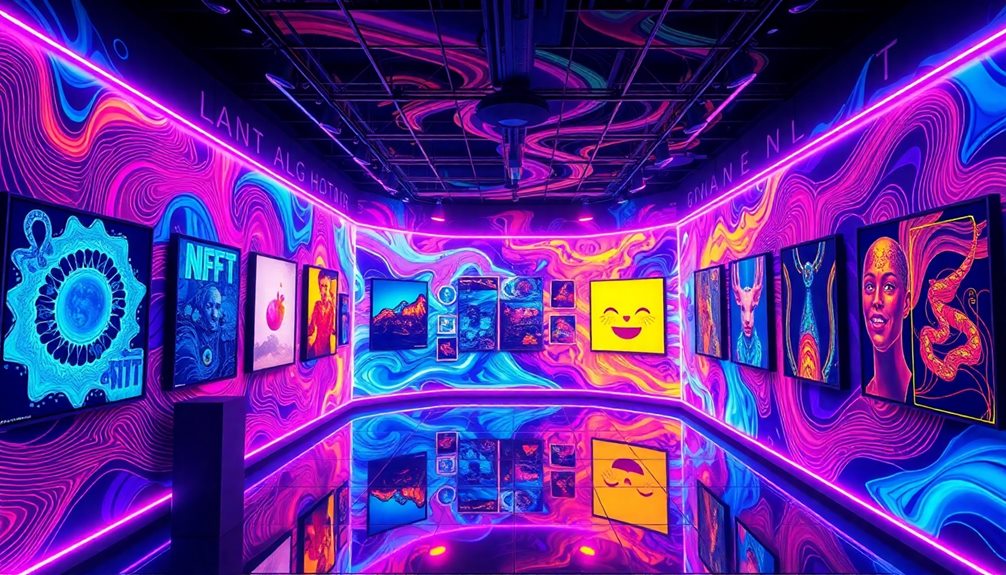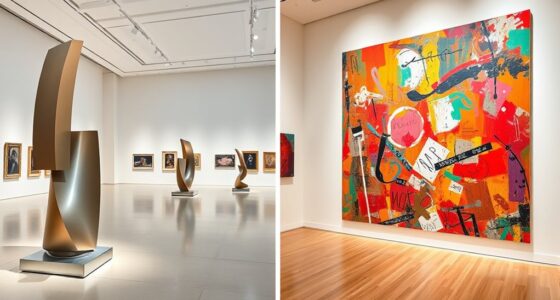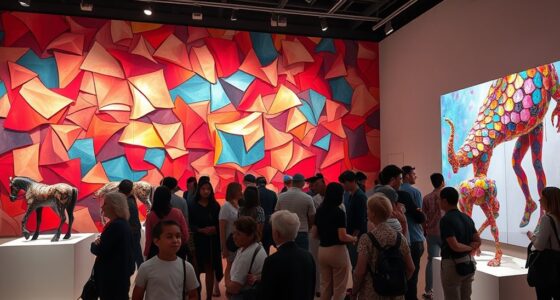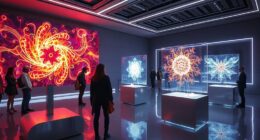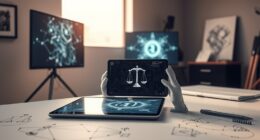NFTs are transforming how you think about art ownership. These unique digital tokens, verified on a blockchain, give you guaranteed ownership and authenticity of digital artworks. When you buy an NFT, you're purchasing the token, not just the digital file. This process supports artists by enabling direct sales and ongoing royalties via smart contracts. You also connect with a global audience through popular marketplaces like OpenSea. While challenges like market volatility and environmental concerns exist, the future of NFTs in art promises more integration and innovative solutions. You'll discover even more intriguing aspects as you explore further.
Key Takeaways
- NFTs establish verified ownership and authenticity of digital art through unique tokens on a blockchain, ensuring each piece is distinct.
- Buying an NFT means acquiring ownership of the token, not necessarily the rights to the digital file itself.
- Smart contracts facilitate royalties on secondary sales, providing artists with ongoing income from their creations.
- Ownership of an NFT does not automatically grant copyright or reproduction rights, which typically remain with the original creator.
- The rise of NFT marketplaces enhances global accessibility, allowing artists to connect directly with collectors and expand their audience.
Definition of NFT Art

NFT art refers to unique digital creations that are tokenized on a blockchain, ensuring you can verify ownership and authenticity for each piece. These digital assets are represented by non-fungible tokens (NFTs), which means each token is distinct and can't be exchanged on a one-to-one basis like cryptocurrencies such as Bitcoin. This uniqueness provides a level of security and value that traditional digital art often lacks.
When you mint an NFT, you're creating a unique token on a blockchain, like Ethereum. This process involves uploading your digital artwork and its associated metadata, effectively turning your creation into a digital certificate of ownership.
As an artist, this innovation allows you to sell your work directly to collectors, cutting out galleries and intermediaries. This shift can greatly increase your revenue potential.
Notable NFT art sales, such as Beeple's "Everydays: The First 5000 Days" fetching $69.3 million, highlight the substantial financial value attributed to NFT art.
The ability to own and trade these unique digital assets is reshaping the art world, giving artists new opportunities and redefining ownership in a digital age.
History of NFTs in Art
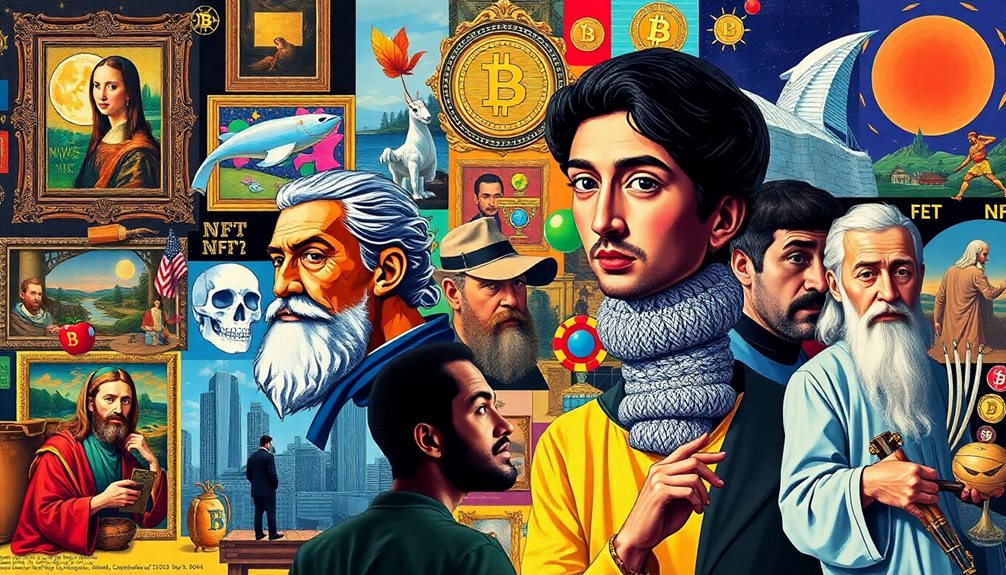
NFTs started to take shape back in 2012 with Colored Coins, but it was the launch of CryptoKitties in 2017 that really showcased their potential in the art world.
By 2021, you saw the explosive growth of NFT art sales, highlighted by Beeple's record-breaking $69 million sale at Christie's.
This evolution not only transformed how art is bought and sold but also opened doors for innovative collaborations between artists and technology.
Early Developments of NFTs
The concept of digital ownership took off in 2012 with the introduction of Colored Coins on the Bitcoin blockchain, paving the way for what would eventually become the NFT market.
These early developments allowed for the creation of digital assets, setting the stage for the rise of NFTs as a means of representing ownership of unique digital artworks.
In 2017, the launch of CryptoKitties notably changed the game, popularizing digital collectibles and sparking widespread interest in NFTs.
This marked a vital point in the evolution of digital art ownership, as collectors began to see the value in owning distinct, verifiable assets on the blockchain.
Fast forward to 2021, and the NFT market exploded, highlighted by Beeple's record-breaking sale of "Everydays: The First 5000 Days" for $69.3 million at Christie's auction house.
Generative art NFTs further transformed the landscape, blending creativity with blockchain technology to produce one-of-a-kind pieces.
Major auction houses like Sotheby's and Christie's began hosting NFT auctions, signaling a pivotal shift in how digital art was valued and sold, forever changing the art world.
Major Milestones in Sales
As digital art gained legitimacy, significant sales milestones underscored the rapid evolution of this new market. In March 2021, Beeple's "Everydays: The First 5000 Days" sold for an astounding $69.3 million at Christie's, marking a pivotal moment for NFTs and propelling digital art into mainstream consciousness.
That same month saw Jack Dorsey's first tweet auctioned as an NFT for $2.9 million, expanding the definition of digital ownership and showing the diverse potential of NFTs.
The first quarter of 2021 alone witnessed NFT sales surpassing $2 billion, driven by heightened interest from collectors and the media. This surge highlighted the burgeoning art market's embrace of digital assets.
Trevor Jones, a key player in the NFT space, demonstrated the financial allure of NFT art by generating $4 million in sales within just a single day.
As major auction houses like Sotheby's and Christie's began hosting dedicated NFT auctions, the art market's approach to digital assets underwent a significant transformation.
This shift not only validated digital art but also opened new avenues for collectors, forever changing how we perceive and engage with art in the digital age.
How NFT Art Functions

NFT art functions through a process called minting, where unique tokens are created on a blockchain to certify ownership and authenticity of digital artworks.
When you buy an NFT, you're acquiring the token that represents the artwork, not the actual file itself.
This system guarantees creators maintain a connection to their work, thanks to smart contracts that automate royalties and sales agreements.
Minting Process Explained
Creating an NFT involves a straightforward yet essential process that artists must follow to establish their digital art on the blockchain. The minting process begins when you upload your digital artwork to a decentralized storage platform, typically using marketplaces like OpenSea. This step not only showcases your creation but also allows you to associate it with unique metadata.
Once uploaded, each NFT you create contains unique identifiers that link it to your digital asset. This guarantees authenticity and ownership, securely recorded on the blockchain. You'll need tools such as digital art software like Photoshop or Blender and a cryptocurrency wallet, such as MetaMask, to facilitate this process.
The minting establishes a digital certificate of authenticity for your artwork, determining its scarcity in the digital domain.
Remember, when buyers acquire your NFT, they're purchasing the token representing ownership, not the actual digital file. This means that rights like reproduction and copyright typically remain with you, the digital artist, unless you decide to transfer them.
Ownership and Authenticity
Understanding how ownership and authenticity function in the NFT space is key to appreciating their value. Non-fungible tokens (NFTs) act as digital certificates of authenticity for unique digital artworks, securely recorded on a blockchain. Each NFT is linked to a specific digital asset through unique identifiers, creating scarcity and confirming originality in the digital landscape.
When you own an NFT, you possess a verified claim to that digital artwork, but it's essential to recognize that this ownership doesn't grant you copyright or reproduction rights. Those rights remain with the original creator.
The minting process involves uploading your digital art to decentralized storage, alongside metadata that locks in the token's ownership and authenticity on the blockchain.
Smart contracts within NFTs also allow artists to earn royalties automatically from secondary sales. This feature guarantees that as the artwork changes hands in the marketplace, creators continue to benefit financially from their work.
Selling and Marketing Strategies

To thrive in the competitive world of digital art, artists need effective selling and marketing strategies that resonate with potential buyers.
First, you should choose popular NFT marketplaces like OpenSea or Rarible to showcase your art NFTs. These platforms expose your work to a large audience and facilitate transactions in Ethereum.
Engaging with the NFT community on social media, especially Twitter and Discord, is essential. Building a following helps enhance the visibility of your work and opens doors for collaborations with other NFT artists and influencers.
You can also explore different pricing strategies, such as fixed-price sales or auctions, while keeping an eye on market trends to determine the best timing for your releases.
Utilizing effective marketing techniques, like teaser campaigns or limited-time offers, can generate buzz and create urgency around your successful NFT sales.
Benefits for Artists

Often, artists find that NFTs offer a revolutionary way to connect directly with collectors, bypassing traditional galleries and agents. This direct access increases your profit margins and gives you more control over your sales.
NFT stands for non-fungible tokens, and they allow you to sell your unique digital creations while ensuring verifiable ownership and authenticity through blockchain technology. This not only enhances the value of your work in the marketplace but also builds trust among collectors and investors.
Additionally, the transparency and security provided by blockchain technology can further reassure both artists and buyers regarding the integrity of their transactions.
One of the most exciting benefits is the ongoing revenue opportunities that NFTs provide. Smart contracts enable you to earn royalties on secondary sales, ensuring you continue to benefit financially from your creations long after the initial sale.
Additionally, the global reach of NFT marketplaces expands your audience, allowing you to connect with collectors worldwide and diversify your customer base.
Leveraging the NFT community on social media platforms can further enhance your visibility and engagement, helping you foster stronger relationships with your audience and potential buyers.
Challenges in the NFT Space

While NFTs offer unique opportunities for artists, they also come with a set of challenges that can complicate the landscape. One major issue is market volatility; you might experience a significant drop in sales, as seen with the reported 60% decline in daily NFT sales by May 2021. This speculative nature can create uncertainty about the value of your work.
Environmental concerns also loom large. The energy-intensive processes of blockchain technology raise questions about sustainability, especially given that Ethereum's annual energy consumption is comparable to that of Iceland.
Legal complexities add another layer of difficulty. Owning an NFT doesn't grant you copyright or reproduction rights of the digital artwork, potentially leaving you confused about your ownership status.
Additionally, a limited understanding of blockchain technology among artists can hinder your ability to navigate the NFT space effectively. This lack of knowledge could lead to missed opportunities for monetizing your work.
Future Trends in Digital Art

The future of digital art is poised for exciting transformations, particularly with the growing integration of NFTs across various creative industries. NFT stands for non-fungible tokens, and they're enhancing monetization potential for artists by allowing unique art to be sold as secure digital files.
You can expect to see more virtual galleries and exhibitions in the metaverse, which will provide immersive experiences for audiences and broaden the reach of digital artists.
As the industry evolves, eco-friendly blockchain solutions are gaining traction, addressing environmental concerns tied to traditional NFT transactions. This push for sustainability will help promote responsible practices within the art community.
Additionally, artificial intelligence is set to play a significant role in creating generative art NFTs, pushing creative boundaries and merging technology with artistry.
To thrive in this competitive NFT market, you'll need to focus on producing unique, high-quality work while maintaining a strong online presence. Auction houses are also adapting to this digital shift, making it easier for you to showcase and sell your art.
Ultimately, the future of digital art looks promising, filled with innovative opportunities and potential for growth.
Frequently Asked Questions
Does Owning an NFT Mean You Own the Art?
Owning an artwork doesn't mean you own its copyright. You can possess a piece, but the creator retains rights. Always check the specific terms attached to your purchase to understand what you really own.
What Are NFTS in Digital Art?
Imagine owning a piece of the digital cosmos! NFTs in digital art are unique tokens that verify your ownership of specific artworks, offering a revolutionary way to collect, trade, and appreciate digital creativity like never before.
Can I Still Use My Art if I Sell It as an NFT?
Yes, you can still use your art after selling it. You'll retain rights unless you specify otherwise. Just clarify what rights you're keeping, so everyone knows what's allowed and what's not.
Who Owns Art Created on a Digital Device?
When you create art on a digital device, you own that artwork. However, selling it may affect your rights. It's vital to understand what ownership entails, especially concerning reproduction and licensing agreements.
Conclusion
As you explore the world of NFTs and digital ownership in art, you'll discover that 75% of artists using NFTs report increased income, showcasing the transformative potential of this technology. Embracing NFTs not only opens up new revenue streams but also democratizes access to art. While challenges exist, the benefits for artists are undeniable. By staying informed and adapting to this evolving landscape, you can harness the power of NFTs to redefine your artistic journey.
